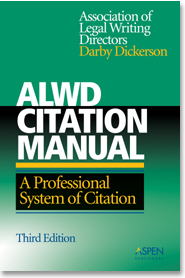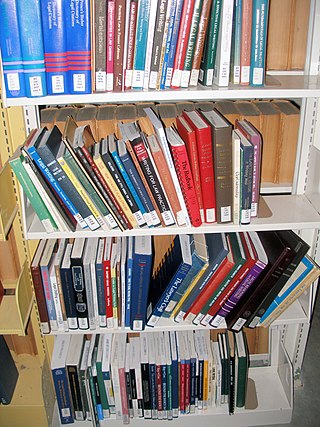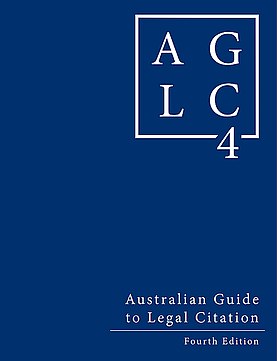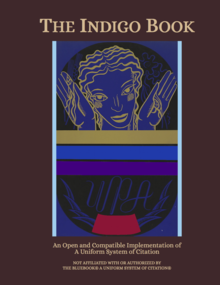In law, a citation or introductory signal is a set of phrases or words used to clarify the authority of a legal citation as it relates to a proposition. It is used in citations to present authorities and indicate how those authorities relate to propositions in statements. Legal writers use citation signals to tell readers how the citations support their propositions, organizing citations in a hierarchy of importance so the reader can quickly determine the relative weight of a citation. Citation signals help a reader to discern meaning or usefulness of a reference when the reference itself provides inadequate information.

Case citation is a system used by legal professionals to identify past court case decisions, either in series of books called reporters or law reports, or in a neutral style that identifies a decision regardless of where it is reported. Case citations are formatted differently in different jurisdictions, but generally contain the same key information.

ALWD Guide to Legal Citation, formerly ALWD Citation Manual, is a style guide providing a legal citation system for the United States, compiled by the Association of Legal Writing Directors. Its first edition was published in 2000, under editor Darby Dickerson. Its sixth edition, under editor Coleen M. Barger, was released in May 2017 by Wolters Kluwer.
The Yale Law Journal (YLJ) is a student-run law review affiliated with the Yale Law School. Published continuously since 1891, it is the most widely known of the eight law reviews published by students at Yale Law School. The journal is one of the most cited legal publications in the United States and usually generates the highest number of citations per published article.
In re, Latin for 'in the matter [of]', is a term with several different, but related meanings.
Legal citation is the practice of crediting and referring to authoritative documents and sources. The most common sources of authority cited are court decisions (cases), statutes, regulations, government documents, treaties, and scholarly writing.

Legal writing involves the analysis of fact patterns and presentation of arguments in documents such as legal memoranda and briefs. One form of legal writing involves drafting a balanced analysis of a legal problem or issue. Another form of legal writing is persuasive, and advocates in favor of a legal position. Another form legal writing involves drafting legal instruments, such as contracts and wills.

The Federal Appendix was a case law reporter published by West Publishing from 2001 to 2021. It collected judicial opinions of the United States courts of appeals that were not expressly selected or designated for publication. Such "unpublished" cases are ostensibly without value as precedent. However, the Supreme Court made a change to the Federal Rules of Appellate Procedure in 2006. Now, Rule 32.1 says that federal circuit courts are not allowed to prohibit the citation of unpublished opinions issued on or after January 1, 2007. Nevertheless, principles articulated in an opinion designated as "not for publication" are treated by the judges of that circuit as not necessarily binding on future panels hearing similar cases, nor on the district judges within the circuit.

The United States Code Congressional and Administrative News(U.S.C.C.A.N.) is a publication that collects selected congressional and administrative materials. U.S.C.C.A.N. was first published in 1941 and has continued to be published in monthly pamphlets. Among other documents, U.S.C.C.A.N. publishes the full text of new federal laws, presidential proclamations, executive orders, federal regulations and sentencing guidelines. Prior to the 99th Congress, the legislative history materials in contained only a House or Senate report. It is recommended by the Bluebook as a citation source.
The Restatement (Second) of the Law of Contracts is a legal treatise from the second series of the Restatements of the Law, and seeks to inform judges and lawyers about general principles of contract common law. It is one of the best-recognized and frequently cited legal treatises in all of American jurisprudence. Every first-year law student in the United States is exposed to it, and it is a frequently cited non-binding authority in all of U.S. common law in the areas of contracts and commercial transactions. The American Law Institute began work on the second edition in 1962 and completed it in 1979; the version in use at present has a copyright year of 1981.
The Texas Law Review is a student-edited and -produced law review affiliated with the University of Texas School of Law (Austin). The Review publishes seven issues per year, six of which include articles, book reviews, essays, commentaries, and notes. The seventh issue is traditionally its symposium issue, which is dedicated to articles on a particular topic. The Review also publishes the Texas Law Review Manual on Usage & Style and the Texas Rules of Form: The Greenbook, both currently in their fourteenth editions. The Texas Law Review is wholly owned by a parent corporation, the Texas Law Review Association, rather than by the school.

The Australian Guide to Legal Citation (AGLC) is published by the Melbourne University Law Review in collaboration with the Melbourne Journal of International Law and seeks to provide the Australian legal community with a standard for citing legal sources. There is no single standard for legal citation in Australia, but the AGLC is the most widely used.

The Canadian Guide to Uniform Legal Citation is a legal citation guide in Canada. It is published by the McGill Law Journal of the McGill University Faculty of Law and is used by law students, scholars, and lawyers throughout Canada. The book is bilingual, one half being in English and the other in French.
The Oxford University Standard for Citation of Legal Authorities (OSCOLA) is a style guide that provides the modern method of legal citation in the United Kingdom; the style itself is also referred to as OSCOLA. First developed by Peter Birks of the University of Oxford Faculty of Law, and now in its 4th edition, it has been adopted by most law schools and many legal publishers in the United Kingdom. An online supplement is available for the citation of international legal cases, not covered in the main guide.

Richard Allen Posner is an American legal scholar who served as a federal appellate judge on the U.S. Court of Appeals for the Seventh Circuit from 1981 to 2017. A senior lecturer at the University of Chicago Law School, Posner was identified by The Journal of Legal Studies as the most-cited legal scholar of the 20th century. As of 2021, he is also the most-cited legal scholar of all time. He is widely considered to be one of the most influential legal scholars in the United States.
A table of authorities is part of a legal brief that contains an index of the cases, statutes, and secondary sources cited. This article deals specifically with the characteristics of tables of authorities in the United States. The table of authorities, often called a TOA, is frequently a legal requirement for litigation briefs; the various state courts have different rules as to what kinds of briefs require a TOA. The TOA list has the name of the authority followed by the page number or numbers on which each authority appears, and the authorities are commonly listed in alphabetical order within each grouping. The intention is to allow law clerks and judges to easily and rapidly identify and access the legal authorities cited in a litigation brief.
Edict of government is a technical term associated with the United States Copyright Office's guidelines and practices that comprehensively includes laws, which advises that such submissions will neither be accepted nor processed for copyright registration. It is based on the principle of public policy that citizens must have unrestrained access to the laws that govern them. Similar provisions occur in most, but not all, systems of copyright law; the main exceptions are in those copyright laws which have developed from English law, under which the copyright in laws rests with the Crown or the government.

The Indigo Book: An Open and Compatible Implementation of A Uniform System of Citation is a free content version of the Bluebook system of legal citation. Founded by New York University professor Christopher Jon Sprigman, authored collectively by Sprigman and a group of NYU law students, and published by Public.Resource.Org, it is an adaptation based on the 10th edition of the Bluebook as published by the Harvard Law Review Association in 1958, which had entered the public domain in the United States because its copyright had expired due to non-renewal.

The California Style Manual, as provided by order of the California Supreme Court and pursuant to statute, is "the official organ for the styles to be used in the publication of the Official Reports" of decisions by California's courts. A person filing a document in a California state court may use either the style for legal citations prescribed in the Manual or the very different system promulgated in The Bluebook: A Uniform System of Citation, but must use the same style consistently throughout the document. Most California state courts, and lawyers practicing in those courts, use the Manual's citation style. The current (fourth) edition of the Manual, published in 2000 by West Group, is freely available online at the Sixth District Appellate Program webpage.












